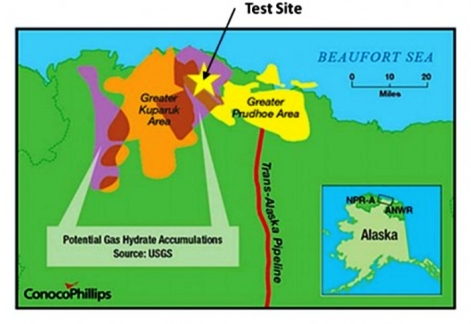Abundance of Methane Hydrates will Destroy the Oil Market
U.S. Department of Energy (DOE)
Secretary Steven Chu contributed a statement to an
announced breakthrough in
research into tapping the vast fuel resource of methane hydrates
that could eventually bolster already massive U.S. natural gas
reserves.
As Al Fin
pointed out yesterday natural
gas is priced to a barrel of oil equivalent at
about $10-$11 per the estimable Geoffrey Styles view,
something less than 10% of the cost of oil. For North
Americans adding a viable and hopefully low cost means to make use
of gas hydrates could be giant boost to low cost fuel sources and a
massive kick to the economy.
For experts the methane hydrates
resource is the largest reserve of hydrocarbons in the planetary
crust. So far humanity has not devised a process to economically
harvest this immense energy wealth. Today’s DOE announcement may
point the way to a new era in abundant energy to build out a bigger
and better world economy.
By
injecting a mixture of carbon
dioxide and nitrogen into a methane hydrate formation (pdf link) on
Alaska’s North Slope, the DOE partnering with
ConocoPhillips and
Japan Oil, Gas and Metals National Corp
was able to produce a steady flow of natural gas in the first field
test of the new method. The test was done from mid-February to about
mid-April this year.

Methane Hydrate Test Site Map of
US DOE, CononcoPhillips and JOGMNC Process Test.
The department said it would likely
be years before production of methane hydrates becomes economically
viable. Secretary Chu said in his statement, “While this is just the
beginning, this research could potentially yield significant new
supplies of natural gas.”
Methane hydrates are cold ice
crystal-like structures that contain methane the chemical of natural
gas. The hydrates are located under the Arctic permafrost and in
ocean sediments along the continental shelf and widely spread
worldwide.

Methane Hydrate Resources per
Der Spiegel.
Gerald Holder, dean of the
engineering program at University of Pittsburgh, who has worked with
the DOE’s National Energy Technology Laboratory on the hydrate
issue, said before the announcement he had been sceptical about what
researchers would be able to accomplish.
He said the main problem until now
was finding a way to extract natural gas from solid hydrates without
adding a whole lot of steps that made the process too expensive,
which makes the success of this new test significant.
“It makes the possibility of
recovering methane from hydrates much more likely. It’s a long way
off, but this could have huge impact on availability of natural
gas,” said Holder.
While everyone is suggesting that
methane hydrate production is some time in the future, we might note
that a partner is from Japan, a country that has been buying via
imports virtually all its energy and fuel inputs. A glance at
the map of potential reserves shows that Japan may well pour on the
intellectual and financial power to get results much quicker than
many expect.
On the other hand, for North
Americans natural gas is ratcheting down to dirt cheap, with more
resources with the new horizontal drilling and reserve fracturing
available on land and significant amounts of natural gas at sea in
already developed areas.
For everyone the matter of coming up
with the CO2 for the injection is going to be a significant issue.
First just gathering it remains a significant problem. Making
it from – natural gas – is the preferred method today. That
raises the question if the CO2 injected is lost to sequestration or
is it recycled for reuse, or what proportion is being lost or
recycled? CO2 is very useful and it may become a valuable
resource in its own right very soon.
Abundance makes a lot of things that
weren’t viable at a price possible at lower costs. Abundant
fission or cold fusion could make electrolysis viable freeing
hydrogen for adding to coal for both liquid fuels and CO2 sources.
Scaling could make such concepts usual and common thinking very
quickly.
For now though the DOE and partner’s
news is very gratifying. It must be giving the futurists at
OPEC an OMG moment, again. Things are going to be changing.
Let’s hope the DOE and the partners
spill some more info soon so we can have a better look.
This article was first published in OilPrice.com on May 9th, 2012.